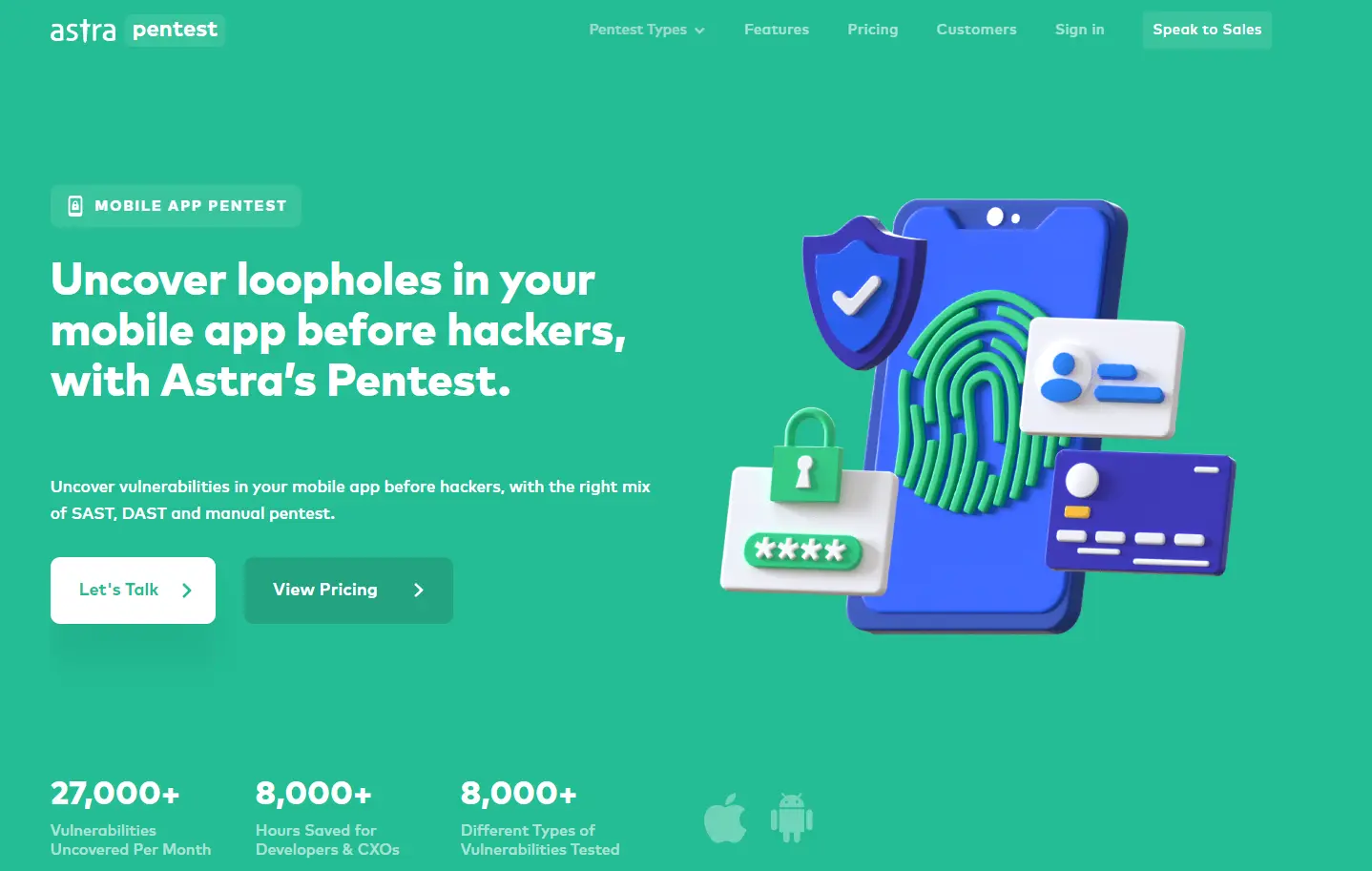Mobile applications have a large share of digital assets, due to their frequent presence in everyday life. As we progress towards a digital age, cybersecurity is an ever-growing concern.
Poor coding and weak security protocols put user data at risk and need to be addressed. Unaddressed security flaws can cause costly data breaches and damage reputations. Robust security is necessary for modern software development.
This article walks you through the mobile app security best practices to ensure high-quality mobile app security. From understanding the importance of secure code to real-time threat detection and stringent app testing, we cover all aspects.
Action Points:
- Mobile application security is vital for protecting user data and enabling technological advancements like IoT.
- Common risks include malware, data leaks, API threats, insecure credentials, code tampering, phishing, and weak server security.
- Adopt mobile app security best practices, including code security, authentication, updates, data encryption, and threat monitoring, to protect user data and maintain trust.
Why Mobile App Security Matters?
- Mobile applications, being a primary point of contact between businesses and users, store crucial user information, necessitating a secure environment.
- Faulty security may lead to data breaches, exposing sensitive user data to potential threats.
- Increasing regulatory pressure commands better data protection, and non-compliance may result in hefty penalties.
- Strong security practices can build and maintain user trust.
- Improper security measures can lead to a damaged business reputation and reduced customer loyalty.
- Effective security features can give a competitive edge in the app market.
- Technological advancements such as IoT applications require high security to function safely.
- As cyber-attacks become more sophisticated, the need for adopting mobile app security best practices rises correspondingly.
Common Risks that Endanger Mobile App Security
Several risks tend to undermine mobile app protection best practices, such as:
1. Malware Attachments
Unsecure third-party integrations can become sources of malware, threatening the security and performance of the mobile application.
2. Data Leakage
Faulty data storage or unsecured communication channels can lead to unintentional data exposure.
3. Everyday API Threats
Repeated use of unprotected APIs allows cybercriminals to exploit application vulnerabilities.
4. Insecure Credential Storage
If user credentials are stored insecurely, they become easy targets for breaching.
5. Code Tampering
Cybercriminals can alter the mobile app’s code to create fraudulent versions or introduce viruses.
6. Unprotected Network Traffic
The use of unsecured networks for app communication can result in data compromise, as information transmitted over such networks can be intercepted and manipulated.
7. Phishing Attacks
Fraudulent attempts to obtain sensitive information by disguising it as trustworthy entities in an electronic communication.
8. Weak Server-Side Security
Insufficient security on the server side paves the way for unauthorized access to sensitive data.
9. Unpatched Software
Using outdated software or failing to regularly update your app can leave it vulnerable to known security threats even with the adoption of other mobile app security best practices.
10. Rogue Mobile Apps
Fake applications are designed to trick users into downloading and providing sensitive information.
11. Insufficient Testing
If an app is not thoroughly tested, undiscovered vulnerabilities can be exploited via cyberattacks.
12. Unrestricted File Uploads
Allowing unrestricted uploads can invite the risk of malicious file upload attacks.
13. Poor Encryption Practices
Inadequate or improperly implemented encryption makes sensitive data more accessible to unauthorized users.
14. Absence of Multi-factor Authentication
Not using multiple layers of security to authenticate users can lead to easy unauthorized access.
15. Improper Session Handling
If user sessions are not managed securely, attackers can hijack sessions and gain access to sensitive information.
Why is Astra Vulnerability Scanner the Best Scanner?
- Runs 8000+ tests with weekly updated scanner rules
- Scans behind the login page
- Scan results are vetted by security experts to ensure zero false positives
- Integrates with your CI/CD tools to help you establish DevSecOps
- A dynamic vulnerability management dashboard to manage, monitor, assign, and update vulnerabilities from one place.
- Helps you stay compliant with SOC2, ISO27001, PCI-DSS, HIPAA, etc.
- Integrates with Slack and Jira for better workflow management
- Trusted by the brands you trust like Agora, Spicejet, Muthoot, Dream11, etc.

23 Mobile App Security Best Practices

1. Secure Your Code
Always encode and encrypt your application code. Implement code obfuscation and runtime protection to make your code harder to breach.
For example: Use tools and plugins to minify and obfuscate the source code. This makes it harder for attackers to reverse-engineer the app.
2. Use Libraries with Caution
Be cautious when using third-party libraries, as faulty libraries can inadvertently introduce security vulnerabilities.
For example: Regularly update and patch third-party libraries. Conduct a thorough security analysis of all libraries you use.
3. Strengthen Authentication Mechanisms
Implement strong user authentication processes. A combination of username, password, and secondary verification like OTPs or biometric authentication can strengthen your app’s security.
For example: Implement multi-factor authentication (MFA) which requires users to verify their identity using two or more independent credentials.
4. Implement Regular Patching & Updates
Regularly release updates and patches to fix identified vulnerabilities. Keeping your app updated reduces the risk of security breaches.
For example: Establish a system for regular app updates and deploy patches as soon as a security vulnerability is detected.
5. Limit Data Storage on the Device
Keeping data storage on the user’s device to a minimum can prevent data theft in case the device is compromised.
For example: Implement a policy of storing sensitive data in secure servers rather than local storage, and enforce data retention limits.
6. Secure All Communication Channels
Ensure that all channels of communication are secured to prevent data interception. Encrypted connections like HTTPS should be the standard.
For example: Use protocols like SSL/TLS for securing the data during transmission.
7. Conduct Regular Security Testing
Testing should be a major part of your security strategy. Regularly test your application for vulnerabilities and fix them before they can be exploited.
For example: Use automated testing tools and manual inspection methods to identify potential security threats.
8. Monitor and Respond to Threats in Real-Time
Have tools in place that can monitor your application and detect threats in real-time. Act immediately on any detected vulnerabilities to maximize security using iOS mobile app security best practices.
For example: Use threat detection software that can identify suspicious activity and alert your team immediately. Implement an incident response plan to act quickly upon detection of threats.
9. Install Only Signed Apps
Ensure that all apps installed on your device are verified and trusted. Signed apps that have been authenticated by the app store and are generally safer.
For example: Restrict users from downloading apps from unknown sources outside of official app stores.
10. Implement Access Controls
Use access controls to limit what each user can see or do within your app. Thus, as one of the mobile app security best practices, this practice with Astra can prevent unauthorized users from accessing sensitive information.
For example: Use role-based access control (RBAC) which allows you to set permissions based on roles within your organization.
11. Encrypt Sensitive Data
Encrypt any sensitive data stored in your app to protect it from unauthorized access.
For example: Use industry-standard encryption algorithms such as AES and RSA for encryption of sensitive data.
12. Ensure Proper Session Handling
Manage user sessions securely to prevent session hijack. Ensure that sessions expire after a certain period of inactivity.
For example: Implement measures like session timeout and single sign-on (SSO) to enhance the security of user sessions.
13. Implement Tamper Detection
Protect your app from tampering by implementing tamper detection mechanisms. These mechanisms of mobile app security best practices can detect whether code has been altered and can respond appropriately.
For example: Use checksums or digital signatures to verify the integrity of the code. If the verification fails, the application can take appropriate actions like not starting up, notifying administrators, or even wiping sensitive data from the device.
14. Secure Server and Network
Ensure that the server and network your app communicates with are secure. A secure server significantly reduces the possibility of malicious attacks.
For example: Use firewalls and intrusion detection systems to protect your servers. Regularly audit your network security to find vulnerabilities.
15. Keep Security Practices Transparent
Communicate with your users about the security measures you’ve implemented. Transparency builds user trust.
For example: Include a privacy policy that outlines the security measures in place.
16. Backup Your Data Regularly
A robust backup strategy ensures that, even in the worst-case scenario, you can recover lost data.
For example: Implement automatic, regular backups, and test your recovery processes to ensure they work effectively.
17. Harden APIs
Your APIs are key touchpoints for your application, and as such, they need to be secure. Ensure that your API is protected from malicious attacks and vulnerabilities.
For example: Use API gateways that provide key features like rate limiting to prevent Denial of Service (DoS) attacks, and data validation to prevent injection attacks.
18. Implement the Least Privilege Principle
Grant only the necessary permissions that are required for the app to function smoothly. Excessive permissions could be potentially exploited by malicious users.
For example: Regularly review the privileges given to different components of your application and revoke permissions that are no longer required.
19. Ensure Secure Error Handling
Improper error handling can disclose information unintended to the users and can be exploited by malicious attackers.
For example: Implement custom error messages that do not reveal specific system details. Always log errors for further analysis and troubleshooting.
20. Investigate Incidents Thoroughly
When a security incident occurs, it’s essential to investigate it thoroughly to understand its cause and prevent a similar occurrence in the future.
For example: Allocate a dedicated team to handle incident analysis. Make sure to record every detail about the incident, including the time of occurrence, impact, and the measures taken to address it.
21. Use a Reliable Authentication System
A robust authentication system will ensure that only legitimate users have access to resources within your app.
For example: You can use OAuth for third-party authentication. It’s a standardized protocol that allows users to access your services without sharing their passwords. Use multi-factor authentication (MFA) to add an extra layer of security.
22. Implement Security Headers
Security headers in your application can help protect against some common types of attack such as clickjacking and cross-site scripting.
For example: Use HTTP security response headers like Content-Security-Policy and X-XSS-Protection to add an extra safety layer to your application against several types of attacks.
23. Participate in a Bug Bounty Program
Inviting external researchers to find vulnerabilities in your application can be a great way of identifying and mitigating potential security flaws.
For example: Launch a bug bounty program where security researchers are rewarded for discovering and reporting security issues. This encourages a proactive approach to discovering and fixing security vulnerabilities before they can be exploited by malicious actors.
Secure Your Digital Assets with Astra Security

It can be daunting to stay on top of all potential threats. Astra Security simplifies the process of adopting mobile app security best practices for you. Astra’s comprehensive, easy-to-use security suite provides proactive protection, including automated security audits, real-time threat defense, malware scanning, and instant hacker blocking. Rest assured, your digital assets are safe with Astra. Learn more here!
Conclusion
In the face of evolving threats, prioritizing mobile app security is not just a competitive advantage; it’s an essential measure to uphold business reputation and regulatory compliance. To mitigate these risks, organizations must adopt a range of mobile app security best practices, including secure coding, regular updates, strong authentication, and real-time threat monitoring.
FAQs
What are the two different types of risk in mobile security?
The two primary types of risk in mobile security are device-level risks and application-level risks. Device-level risks encompass threats related to the physical device, such as loss or theft. Application-level risks involve vulnerabilities and threats associated with the mobile apps themselves, including data breaches and malware infections.
















